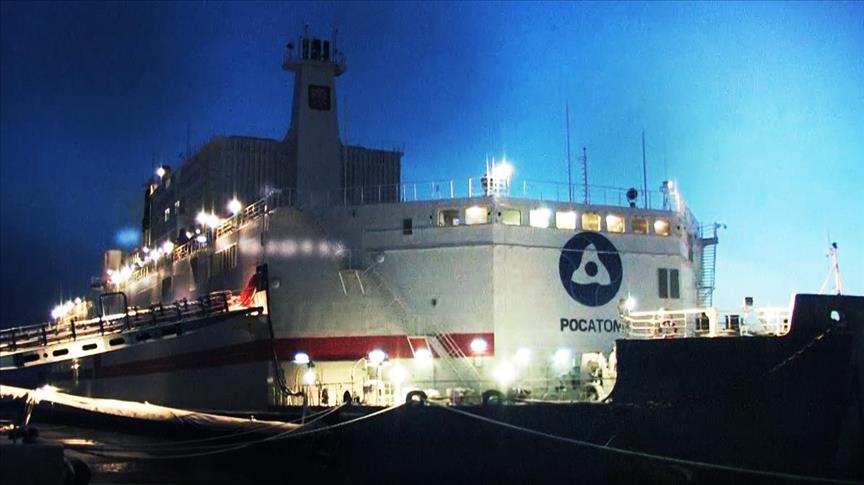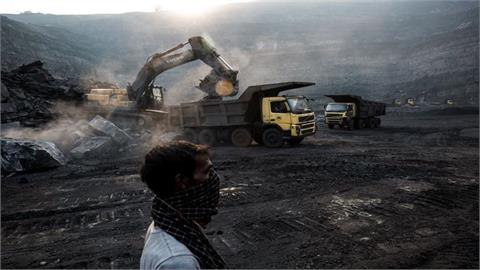The world's first floating nuclear power plant "Akademik Lomonosov" will boost the socio-economic development of the region and be a key infrastructural element in the Northern Sea Route (NSR) project, a shipping lane runs along the Russian Arctic coast, a Russian official said.
The world's first floating nuclear power plant "Akademik Lomonosov" will boost the socio-economic development of the region and be a key infrastructural element in the Northern Sea Route (NSR) project, a shipping lane runs along the Russian Arctic coast, a Russian official said.
As not only will it provide energy but also heat to the Far North ports, where it is planned for NSR traffic to pass through, Vitaly Trutnev, director for the construction and operation of the floating nuclear power plants at Rosenergoatom Concern JSC, a branch company of Russia's nuclear energy giant Rosatom's, told Anadolu Agency on Friday. Designed to operate for about forty years, the plant will become the baseline power generation facility in the country's far east autonomous region of Chukotka.
"There are over 50,000 people who live and work in the region, so, this is not only about long-term sustainable development, which is impossible without a stable energy supply, but also about the region's energy security," Trutnev said.
"The floating plant will not only replace the decommissioned Bilibino Nuclear Power Plant but also the working Chaunskaya Power Plant that uses brown coal as fuel, probably the most harmful type of fuel. So, as well as ensuring the elimination of harmful emissions in the Arctic ecosystem, Akademik Lomonosov is also a guarantee that the region's inhabitants will not be left without light and heat in the freezing Far North," Trutnev explained.
The plant equipped with two 35 megawatt KLT-40C reactor systems similar to those used on icebreakers, is capable of generating enough electricity for around 100,000 homes, according to company.
Akademik Lomosonov, of which the construction took over a decade, was grid-connected on Dec.19 to release first kilowatt-hours of electricity in Russia's northernmost town of Pevek on the Arctic coast, while commercial operation is expected to start in 2020.
- A floating plant amid safety concerns
Akademik Lomonosov is the lead project in a series of low-power transportable power units, built from start to finish in shipyards, using the same expert construction technology as on nuclear icebreakers and navy ships, according to Trutnev. "The floating plant is installed with the same type of reactors that have decades of safe operations on nuclear-powered icebreakers," Trutnev said.
He explained that the only difference is that the reactor on the floating plant is not used for a safe passage through the Arctic sea but to power remote regions, where it is practically impossible to transport electricity by land. However, the floating plant also raised safety concerns among environmental groups that the plant could fall victim to a disaster.
Commenting on those concerns, Trutnev said that the plant meets the highest safety standards, adhering to both post-Chernobyl and post-Fukushima safety requirements. "The probability of a giant asteroid destroying our planet in the coming decades is twice more likely to happen then to be a severe accident at the Akademik Lomonosov," Trutnev said.
The company took into account all possible and even the most unlikely extreme scenarios when developing the plant's design and strength of its structures, Trutnev said and added "All emergency scenarios were repeatedly modelled and tested."
"The maximum height of waves off the Siberian coast can come to 3 metres. We have tested the reliability and stability of the plant to withstand waves 20 times higher than 6 metres [120 meters]. In addition, the vessel can remain stable under winds of up to 80 meters per second. The maximum list of the vessel is only 3-5 degrees, which means that any strong storms, waves or flooding will not cause the ship to capsize, and thus will not require the reactor to be shut off," Trutnev said.
According to Trutnev, Akademik Lomonosov is designed in such a way that even in the face of a severe accident, the probability of radioactive substance leaking into the environment is absolutely negligible.
"Any system failure that the plant may suffer will not lead to an accident," Trutnev said and added "Even in the absolutely unbelievable event that all active --- operator-driven --- safety systems fail simultaneously, the passive safety systems ensure reactor shut down and makes it watertight, preventing any radioactive substance leak."
- Economic viability
"In hard-to-reach areas, price and cost of electricity is much higher than in a average national grid, so this ensures enough revenue to make a fair return on investment in plant when they are built in series," Trutnev commented on the questions whether a floating plant is economically viable power provider.
"The plant requires more upfront investment but unlike wind turbines and solar panels --- which normally only operate at 15-20% of their installed capacity with a service life, especially in the Arctic, of just 20-25 years --- a nuclear plant operates at 90% of its capacity for about twice as long. If you divide the amount of upfront investment by the number of kilowatt-hours output over the entire life of the plant, the floating plant is cheaper than alternatives," Trutnev explained.
According to Trutnev, as it is a pilot project, it will be more expensive and take longer to build than subsequent serial projects will. "This rule is not just applicable to the nuclear industry but was also true of first solar panels constructed. Cost reduction comes with the economies of scale and the learning curve," he explained. However, overall costs of the plant have not been disclosed as the project is yet to be completed, Trutnev said.
- Russia's aim to export floating plant
Rosatom is already working on second generation floating plant, which will be equipped with two RITM-200 reactors each with a capacity of 50 megawatts. Having a greater power capacity, new plants will be smaller than their predecessors, according to the company.
"The target price for the serial version of floating plants installed with a RITM-200 reactor are aimed towards successfully competing with both fossil fuels and renewables, as well as with the possibility to enter the national grid through long-distance power lines," Trutnev said.
Rosatom hopes to sell floating plants to countries around the world, as the company previously announced that it signed agreement with countries, like Sudan, to explore the possibility of building floating plant.
According to Trutnev, floating plants are adaptable to various weather conditions including low temperatures of the far north and hot tropical climates without sacrificing safety and can be a solution to hard-to-rich coastal areas and locations that are remote from central grids.
(Anadolu Agency)




